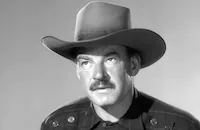Cattle King

Brief Synopsis
Cast & Crew
Tay Garnett
Robert Taylor
Joan Caulfield
Robert Loggia
Robert Middleton
Larry Gates
Film Details
Technical Specs

Synopsis
In Wyoming during the 1880's, Sam Brassfield, a successful rancher who fences in his land for controlled grazing, opposes the National Cattle Trail, which would open up vast territories and eventually destroy the rich grasslands. His principal opponent is Clay Mathews, a ruthless cattle speculator who has won the support of Harry Travers, the cowardly brother of Brassfield's fiancée, Sharleen. As the situation worsens, Mathews' men cut fences, shoot one of Brassfield's ranch hands, and raid the ranch of homesteader Abe Clevenger, placing the blame on Brassfield. Clevenger tries to kill Brassfield, but he is wounded, and while recuperating at the Brassfield ranch, Clevenger learns the truth about Mathews' plans and his strong-handed tactics. Brassfield travels to Cheyenne and makes a protest to President Chester Arthur who, after paying a surprise visit to Brassfield, sides with the ranchers. Believing that Travers has also been won over, Mathews attempts to have him killed, but it is Sharleen who is fatally wounded. Supported by Clevenger and the other homesteaders, Brassfield and his men are able to defeat Mathews in a final gun battle.

Director

Tay Garnett
Cast

Robert Taylor

Joan Caulfield
Robert Loggia

Robert Middleton

Larry Gates
Malcolm Atterbury

William Windom
Virginia Christine

Ray Teal
Richard Devon
Robert Ivers
Maggie Pierce
Woodrow Palfrey
Richard Tretter
John Mitchum
Crew
Seth Banks
Henry E. Brill
Harvey Clermont
Ted Driscoll
Walter Holscher
Nat Holt
Grant R. Keats
George E. Marsh
Bill Naylor
William Persons
Clarence Peterson
Paul Sawtell
Bert Shefter
William Snyder
Thomas Thompson
Thomas Thompson
George White

Film Details
Technical Specs

Articles
Cattle King
Helping tremendously was the presence of a team of Western veterans behind the cameras. Producer Nat Holt had gotten his start in the genre in 1946 with RKO's Badman's Territory, then had moved into television with such series as Tales of Wells Fargo and Overland Trail. Writer and associate producer Thomas Thompson had worked primarily on television Westerns, scripting episodes for such acclaimed series as Rawhide, Bonanza and The Virginian. He would go on to pen best selling novels (Celebrity) and true-crime books (Serpentine). Director Tay Garnett had helped Taylor give one of his best performances, in the World War II epic Bataan (1943). Although he had done few big screen Westerns -- he was best known for the classic film noir The Postman Always Rings Twice (1946) -- television's inroads on movie production had sent him to the small screen. There he was a fixture on some of the series Thompson had penned.
Joining Taylor on screen were a strong cast of veterans and some talented newcomers. His leading lady, Joan Caulfield, had been one of the top box office stars of the '40s in films like Blue Skies (1946) before turning to low-budget Westerns like this in a futile effort to build a new career as a character actress. She's probably best known, however, for the fact that the marquee for her film Dear Ruth (1947), in which she co-starred with William Holden, gave J.D. Salinger the name for the protagonist of Catcher in the Rye, Holden Caulfield. Corpulent villain Robert Middleton had cornered the market on evil as the demented killer in The Desperate Hours (1955) and a murderous knight in The Court Jester (1956). Larry Gates, who pretty much stole the film as President Chester A. Arthur, was a stage veteran who would go on to win a Daytime Emmy as oil magnate H.B. Lewis on Guiding Light.
Contemporary audiences may focus more on three cast members destined for bigger things. Middleton's violent henchman, Robert Loggia, would go on to become one of Hollywood's top character actors after winning an Oscar® nomination for Jagged Edge in 1985. William Windom, cast as Caulfield's drunken brother, was destined for television stardom on such series as The Farmer's Daughter and My World and Welcome to It. Most recognizable, however, is rancher's wife Virginia Christine, soon to achieve stardom as the Swedish-accented Mrs. Olson in a series of coffee commercials.
Using the same economy they had developed for their television work, Holt and Garnett shot Cattle King in just three weeks. Much of the filming was done on the Walker Ranch and Western Street in Kernville, Calif. The popular film location had figured in films since the silent days, most notably in John Ford's classic Stagecoach (1939). Most recently, it was used in the 2001 Kevin Spacey drama K-PAX.
Producer: Nat Holt
Director: Tay Garnett
Screenplay: Thomas Thompson
Cinematography: William E. Snyder
Art Direction: Walter Holscher
Music: Paul Sawtell, Bert Shefter
Principal Cast: Robert Taylor (Sam Brassfield), Joan Caulfield (Sharleen), Robert Loggia (Johnny Quarto), Robert Middleton (Clay Mathews), Larry Gates (President Chester A. Arthur), William Windom (Harry Travers), Virginia Christine (Ruth Winters).
C-91m.
by Frank Miller

Cattle King
Quotes
Trivia
Notes
Location scenes filmed in California. Also known as Guns of Wyoming.

Miscellaneous Notes
Released in United States 1963
Scope
Released in United States 1963













